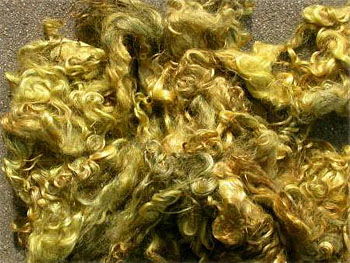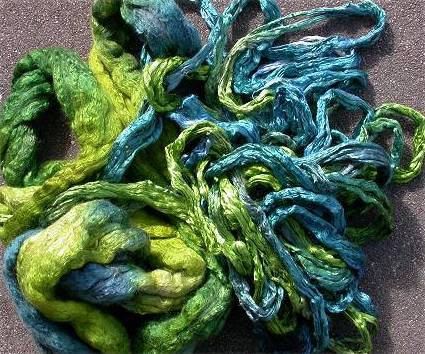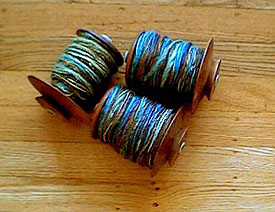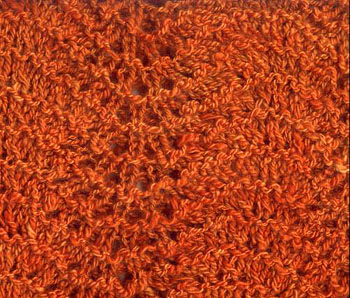
 Okay,
for a few months now you've been dabbling
in Kool-Aid
dyeing, and love the feeling of creating
your own colors. But what if you don't like
candy colors? What if that sickly sweet smell
makes you gag, or makes your cat drool? You,
as an ordinary individual, have access to
a hundred years of chemical research, and
you can use exactly the same dyes as industry
does - the ones where the fabric will shred
decades before the colors fade. Better yet,
you may want to use animal-protein fibers
as a substrate, not just wool and silk but
luxury exotic stuff from cashmere to possum.
These allow you to use acid dyes, possibly
the easiest ones ever invented. In fact, they
pretty much work like Kool-Aid, which is where
assiduous Knitty reading is its own reward.
Okay,
for a few months now you've been dabbling
in Kool-Aid
dyeing, and love the feeling of creating
your own colors. But what if you don't like
candy colors? What if that sickly sweet smell
makes you gag, or makes your cat drool? You,
as an ordinary individual, have access to
a hundred years of chemical research, and
you can use exactly the same dyes as industry
does - the ones where the fabric will shred
decades before the colors fade. Better yet,
you may want to use animal-protein fibers
as a substrate, not just wool and silk but
luxury exotic stuff from cashmere to possum.
These allow you to use acid dyes, possibly
the easiest ones ever invented. In fact, they
pretty much work like Kool-Aid, which is where
assiduous Knitty reading is its own reward.
You may have thought professional
dyeing was a messy, mysterious and possibly
toxic process. Your hippie mother might have
destroyed a couple of washing machines trying
to support a tie-dye t-shirt habit in the
'70s. But this is likely due to using Procion-type
dyes, which work on cellulose/plant fibers.
They do require a non-plumbing-friendly environment,
enough salt to desertify a small town, and
washing out a lot of dye chemicals into the
sewers. The 'natural' dyes usually presented
as alternatives aren't much better. Not only
do they give pretty unreproducible colors,
they often involve poisonous or endangered
plants, and much of their use requires mordants
to set, a euphemism for toxic heavy metals.
On top of that, they often work slowly enough
that the smelly mess is left out for long
periods of time, inviting accidents from passing
kiddies or pets.

Acid dyes however are a
lot friendlier, both to you and the environment.
They are, of course, toxic in a long-term
carcinogenic kind of way; you
don't want to ingest them. But their bad effects
are mostly due to inhaling
them in powder form, just like Kool-Aid. If
you mix standard solutions in
water with reasonable precautions (outside,
out of the wind, with gloves and
mask on on) you're pretty safe from then on.
The solution can keep for weeks or months
in the fridge, so you can make enough of it
in calm, safe
conditions. Then all you need is to wear rubber
gloves, and to use separate
containers for your dyeing - not your cooking
pots. No dye will escape in
the air, even in the steam generated by simmering,
and if you wipe spills
promptly, it's easy to prevent newly dried
powder from getting airborne in
your kitchen. This is one of the things that
makes acid dyes so friendly to
apartment dwellers. All you'll be adding to
help the dye set is a bit of
ordinary white vinegar, which can even be
neutralized with a pinch of baking
soda before disposal if you're concerned about
a septic system. If you get
anywhere near the appropriate dye quantity
for your fiber, which is
recommended from an economical point of view
anyway, all the dye will
'exhaust' or be bound to the fiber, and you'll
only be pouring away
practically clear water. Doesn't all that
sound much better?
On
another level, while acid dyes seem proportionally
a bit more expensive than other types by weight,
if you consider that they're extremely effective
and don't require any extra chemicals, they're
actually one of the cheapest ways to go. Likewise,
any equipment you're likely to need is just
another set of cooking stuff, best acquired
at the local thrift shop. A cheap enameled
canning/stew pot (standard 3 US gallons) is
about right for a sweater's worth of fiber.
You might at most want a vegetable steamer
to put in there, some measuring spoons, and
I use disposable chopsticks recycled from
takeout adventures for stirring. The only
place where you might want to invest good
money is in your dust mask, and in brand-name
plastic: Saran Wrap (original) and Ziploc
bags will be easier to manipulate and will
not melt in the later stages.

 As
in any other dyeing, you can start with fiber
in any form, as long as it's a protein fiber
-- that is, some animal was involved in the
growing.
As
in any other dyeing, you can start with fiber
in any form, as long as it's a protein fiber
-- that is, some animal was involved in the
growing.
Most knitters will
want to start with yarn, possibly very cheap
yarns in icky to horrifying colors from the
sales bin :-). But you can also start with
clean fleece or prepared roving, or dye a
finished product such as a sweater or fabric.
You can start with white and get anything,
or you can dye over natural-colored wool or
tussah silk for more toned-down effects. And
even more conveniently you can overdye other
colors. Which means there are NO mistakes
in dyeing - if you don't like the results
you simply add another layer of color till
you get something you like. The only caveat
is to start with lighter/ brighter colors
and work your way to the darker ones slowly.
And I'd also add a small warning peep from
the Voice of Experience about trying to mask
stains with dark dyes, even deep black ones
- it doesn't work.
You want to make some
attempt to weigh your dry fiber before you
start, because it determines the optimal amount
of dye you'll need. This doesn't have to be
very exact. You can take on faith the label
on yarn balls, you can use a postal scale
and add up smaller quantities, you can even
use a good bathroom scale and estimate the
difference between you weight and that with
the yarn. The reason is that you want to aim
for about 1-3 grams of dye per hundred grams
of dry fiber. You can use less if you want
a more pastel look or a subtle overdye, more
if you want intense colors, a mix of both
for more design interest.
The easy way to figure this out, if you don't
want to be dorking with esoteric, expensive
equipment like gram-scales, is via solutions.
If you make a 1% dye solution, one gram dye
per 100ml water, you can easily calculate
how much solution you need to get a certain
weight of dye into your fiber. The nasty trick
here is that the volume of a gram of dye varies
slightly by color, so do weigh accurately
if you can, but 2 teaspoons will generally
cover it. And do I need to mention that this
is one occasion where abandoning anti-metric
prejudices will really work in your favor?
Unless you're really into fraction masochism,
metric is your ticket to getting close to
the desired results even with relatively low-tech
equipment.
It's important that the fiber be thoroughly
wet before you start. And in animal fibers,
it's particularly important that fiber be
clean and de-greased. The best way to achieve
this, even if your fiber already looks clean,
is to soak it overnight with a shot of Dawn
dish detergent. You don't have to rinse out
the detergent as you dye, it doesn't interfere
with the dyeing process and in fact it might
help minimize fulling.
You can apply the dye directly in what's generally
called 'yarn painting'. You lay skeins out
on Saran Wrap. Then you can use sponges, stencil
brushes, gloved fingers or whatever strikes
your fancy to apply dye solution, diluted
with a bit of vinegar, in various colors and
patterns, working more or less hard to have
the dye penetrate the fiber as desired. Or
you can do one of my favorites and use syringes
to inject the dye directly into balls, which
gives small repeats well suited for knitting.
Whatever the method, the idea is to have several
colors work together and to slap the dye solution
on directly where you want it. Or you can
use better-known immersion methods, and get
a fairly uniform single color all over your
fiber, dunking it in proportionally large
amounts of water in a big pot.

 The important point is that you need to not
only get the dye onto your fiber, but you
need it to chemically bind, to actually become
part of the fiber. This works best if you
use the twin secrets of acid dyeing: acidity
and heat. It doesn't take much acidity to
do the trick, the general rule is a glug of
vinegar per potful. That's right, a glug -
a scientific measurement of what happens when
you just tip the bottle. A small glug will
still work, perhaps not so well if you're
using very alkaline well water. A large glug
will work well if perhaps a bit too quickly,
and pure vinegar won't work any better. A
small point to remember here is that acidity
doesn't harm protein fibers, in fact slight
acidity is good for them. Remember how grandmas
used to rinse their hair with dilute vinegar
or lemon before commercial conditioners came
about?
The important point is that you need to not
only get the dye onto your fiber, but you
need it to chemically bind, to actually become
part of the fiber. This works best if you
use the twin secrets of acid dyeing: acidity
and heat. It doesn't take much acidity to
do the trick, the general rule is a glug of
vinegar per potful. That's right, a glug -
a scientific measurement of what happens when
you just tip the bottle. A small glug will
still work, perhaps not so well if you're
using very alkaline well water. A large glug
will work well if perhaps a bit too quickly,
and pure vinegar won't work any better. A
small point to remember here is that acidity
doesn't harm protein fibers, in fact slight
acidity is good for them. Remember how grandmas
used to rinse their hair with dilute vinegar
or lemon before commercial conditioners came
about?
Heat is another matter. The point is to bring
the fiber as close as you can
to boiling-water temperature, and to keep
it there a while -- about 15
minutes. If
you're using immersion dyeing, there's no
problem there, you just simmer the stuff,
and wait till the color is just what you want,
and/or till the water is clear. The trick
is to resist stirring if you're dyeing something
wooly. Remember that agitation in hot water
is a prime way to full wool... So you must
squash the urge to futz, or you'll have a
prettily colored hideous mess on your hands.
You might have to leave the room. You also
might consider that a roiling boil could cause
mild agitation. So you should try to keep
the water at Chinese tea making temperature
- steam rises off the top, but no actual bubbles
occur.
If you've painted
your fiber, you won't want to blur the results
irretrievably by dunking them in a lot of
water, what you need to do instead
is to steam. You can use the same Saran Wrap
that was protecting your counter to wrap the
fiber. You should probably seal the whole
thing into a Ziploc bag as well, if you painted
several colorways in one session and don't
want any potential mixing. Then into the usual
pot, with a couple inches of water at the
bottom and with an ordinary vegetable steamer
to hold the packages out of the water. The
length of time to steam is a more delicate
matter: larger bundles take longer for the
steam temperature to reach the inside. This
is just like cooking big Russet potatoes whole,
or cut up in pieces, you have to adjust the
cooking time according to the size of the
item, and to the general contents of the pot.
It's not unreasonable to steam a potful of
painted yarn an hour or so. And be sure not
to rinse till the whole thing is back to room
temperature, since more dye will be absorbed
in the cooling process.

 One
consequence of all this is that you can influence
how sharp your color delineation will be,
or how even vs heathered your solid colors.
Say you want to tone down a lovely cashmere
sweater in a tooth-stripping fluorescent color,
like I recently did. If you want an even color,
you'll soak the fiber thoroughly first, and
use a lot of water so that the dye gets to
all the fiber easily. You'll dunk it in almost
room-temperature water, and increase the heat
slowly. And finally you'll add the vinegar
slowly toward the end. If on the other hand
you want to get heathered yarn, or even have
some fabric come out almost tie-dyed, you'll
use all the opposite strategies. Be stingy
with the water so it's harder for the dye
to propagate. Dunk the fiber in already-simmering
water with a generous helping of vinegar,
maybe as much as a cup. Some of this also
applies to yarn painting: if you want a soft,
watercolor
One
consequence of all this is that you can influence
how sharp your color delineation will be,
or how even vs heathered your solid colors.
Say you want to tone down a lovely cashmere
sweater in a tooth-stripping fluorescent color,
like I recently did. If you want an even color,
you'll soak the fiber thoroughly first, and
use a lot of water so that the dye gets to
all the fiber easily. You'll dunk it in almost
room-temperature water, and increase the heat
slowly. And finally you'll add the vinegar
slowly toward the end. If on the other hand
you want to get heathered yarn, or even have
some fabric come out almost tie-dyed, you'll
use all the opposite strategies. Be stingy
with the water so it's harder for the dye
to propagate. Dunk the fiber in already-simmering
water with a generous helping of vinegar,
maybe as much as a cup. Some of this also
applies to yarn painting: if you want a soft,
watercolor
effect, let your fiber sit for 20 minutes
before you start steaming it,
giving the dyes a chance to diffuse and mix.
If you want clearly delineated colors, rush
them to the steam pot the instant you're done
painting.
Rinsing is part of the process, but doesn't
need to be done immediately, since nothing
will harm the fiber. A dash of Dawn will be
helpful in washing out every trace of unbound
dye. If you've measured your dye, you should
get pretty quickly to clear water. If not,
you may not have steamed/simmered your fiber
enough, and you might want to give it another
whirl in the pot, perhaps with a dash more
vinegar. In any case, keep in mind that wool
is still vulnerable to fulling even if you're
rinsing, so don't wring it about vigorously,
don't stream water right over it, just lay
it down gently on clean water to soak and
leave it alone a bit.
Pro-chem
sells Sabraset acid dyes, the best available.
Dharma
Trading merely calls them 'acid dyes'.
Great selection of stuff to dye on too.
Mendel's
sells Jacquard brand, best on silk but a fine
all-around acid dye, in smallish quantities.
Synthetic
Dyes for Natural Fibers
by Linda Knutson.
Interweave Press, 1986, out of print.
This is definitely THE textbook for synthetic
dyeing. Simple, straightforward, and extremely
thorough, you'll never need another.
Blue
and Yellow Don't Make Green
by Michael
Wilcox. School of Color Publishing, 2002.
An excellent text about how color really works
in different media, including color perception.
Introduces the concept of using different
primaries to get different color effects,
and shows color wheels for many combinations.
The
Twisted Sisters Sock Workbook: Dyeing, Painting,
Spinning, Designing, Knitting
by
Lynne Vogel. Interweave Press 2002
Fine for socks, but really great as a dyeing
text. Shows what can only be acquired by long
and painful experience otherwise, the relationship
between the look of a roving or yarn to how
it knits up.
Thanks to Judith McKenzie,
Sara Lamb and Nancy Finn for great workshops,
and to Nancy Roberts for the initial inspiration.

